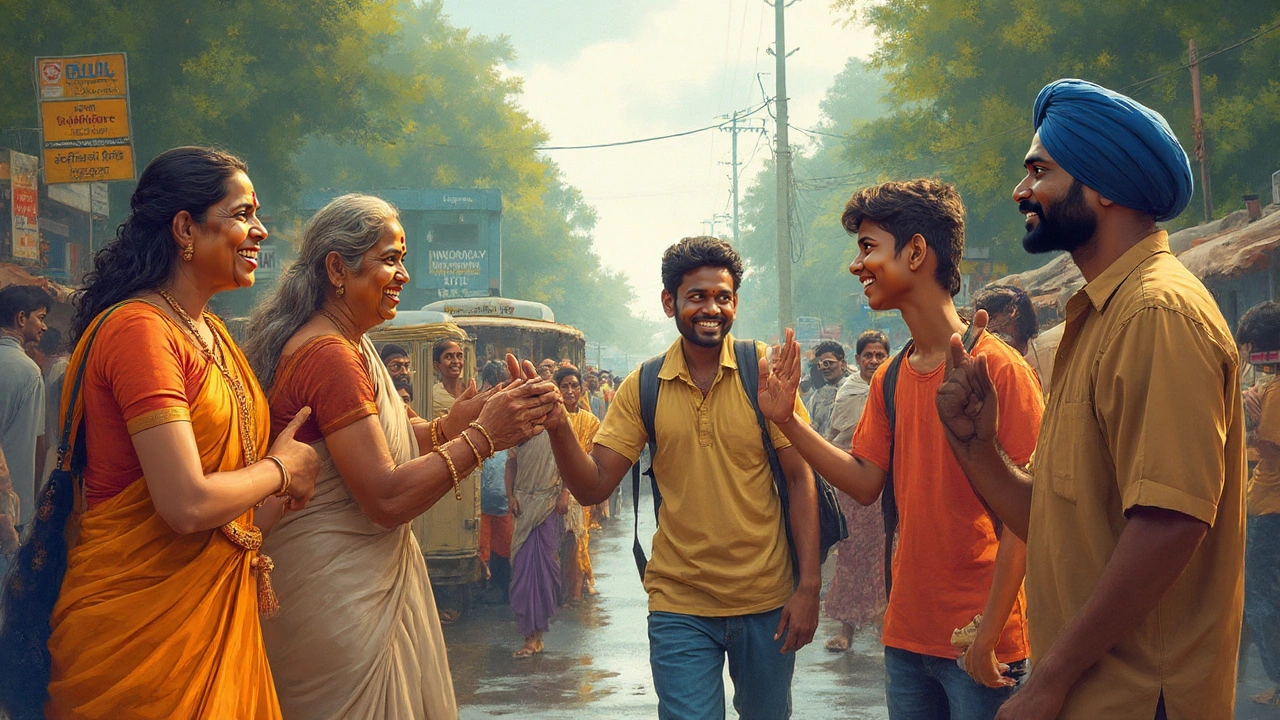You can absolutely say hi in India, but context is king. In big cities, 'hi' or 'hello' is routine. Around elders, at temples, or in formal settings, a namaste or regional greeting lands better. If you want to fit in without overthinking, use this simple playbook: match the tone to the place, add a respectful gesture when needed, and you’ll be fine. I grew up in India and now live in Toronto with my son Kanishk, and every trip back reminds me how far a small, thoughtful greeting goes.
TL;DR: Do you say hi in India?
- Yes, 'hi' is normal in urban and casual settings. In formal, religious, or elder contexts, go with 'namaste' or the local greeting.
- When unsure: say 'Namaste' with a light smile and palms together at chest level. It suits almost every situation.
- Use titles and respect markers: Sir/Ma'am, ji (Ravi ji), aap (formal you). Avoid first-name only with elders until invited.
- Business: 'Hello' + handshake is common; 'Namaste' is equally professional and neutral. Many prefer it post-pandemic.
- Region quick hits: Hindi belt 'Namaste', Punjab 'Sat Sri Akal', Tamil Nadu 'Vanakkam', Telangana/AP/Kerala 'Namaskaram', Bengal 'Nomoshkar', Islamic 'Assalamu Alaikum', response 'Wa Alaikum Assalam'.
How to greet in India, step by step (for any situation)
If you only remember one phrase, remember this: how to say hello in India depends on where you are, who you are greeting, and what the setting is. Here’s a no-drama way to get it right.
Scan the context in 2 seconds.
- Casual or formal? (Street chai stall vs meeting a professor.)
- Age and hierarchy? (Elders, bosses, religious leaders.)
- Setting? (Home, office, temple, mosque, gurdwara, store.)
Pick your opener.
- Casual/urban peers: 'Hi' or 'Hello' works. Time-of-day greetings also work: 'Good morning'.
- Formal/with elders/religious place: 'Namaste' or the local greeting (see regional list below).
- Business: 'Hello' + name/title or 'Namaste' if you want culturally safe and warm.
Add the right gesture.
- Namaste: gently press palms together at chest height, slight head nod. Don’t over-dramatize.
- Handshake: common in offices; keep it light. With women you don’t know, wait for them to initiate.
- No hugs unless you’re already close. Air-kissing isn’t a thing outside certain circles.
Use respectful language.
- Hindi/Urdu: use 'aap' instead of 'tum' or 'tu'. Add 'ji' to soften: 'Namaste ji', 'Thank you ji'.
- Titles: Sir/Ma’am, Doctor, Professor, Uncle/Aunty (common for family friends), Bhaiya/Didi for service staff (polite, friendly).
Follow with a simple connector.
- Safe small talk openers: 'How are you?' 'All good?' 'How’s your day?' In Hindi: 'Aap kaise hain?' (to a woman: 'aap kaisi hain?').
- Business: 'Thanks for making the time.' 'Looking forward to working together.'
Quick default for awkward moments: smile, soft 'Namaste', slight head nod. Works everywhere from a village doorstep to a five-star lobby.

Examples and phrases you can actually use (by place, language, and setting)
India is layered. The exact words shift by region and community. You don’t need to memorize a hundred phrases-just pick the one that fits your route.
North & Central India (Hindi/Urdu belt)
- Universal: 'Namaste' (formal-neutral), 'Namaskar' (more formal), 'Pranam' (elder-facing in some families).
- Everyday: 'Hello'/'Hi' in cities. Time-of-day greetings welcome.
- With elders: 'Namaste Uncle/Aunty', 'Pranam Dadaji' (grandfather).
- Religious settings: 'Ram Ram' (Rajasthan/UP), 'Radhe Radhe' (Mathura/Vrindavan), 'Jai Shri Ram'/'Jai Mata Di' among some devotees.
- Islamic greeting: 'Assalamu Alaikum'; reply 'Wa Alaikum Assalam'. 'Adaab' is a secular Urdu greeting, polite and refined.
Punjab & Sikh communities
- Gurdwara, Sikh families: 'Sat Sri Akal' (respectful, all-purpose). Add slight head nod. In business, 'Hello' works too.
Gujarat
- 'Namaste', 'Jai Shri Krishna' in many families. Everyday: 'Kem cho?' means 'How are you?'
West Bengal, Tripura, Bengali speakers
- 'Nomoshkar' (formal-neutral). Everyday: 'Hello', 'Namaste' also fine.
Maharashtra (Marathi)
- 'Namaskar' (formal), 'Namaste' (neutral). 'Hello' common in Mumbai, Pune offices.
Tamil Nadu (Tamil)
- 'Vanakkam' (universal, respectful). Use palm-together gesture softly. City life: 'Hello' normal in many spots.
Telangana/Andhra Pradesh (Telugu)
- 'Namaskaram'. Casual 'Hello' fine in Hyderabad offices.
Karnataka (Kannada)
- 'Namaskara'. 'Hello' in tech and startups is standard.
Kerala (Malayalam)
- 'Namaskaram' and 'Namaste' both understood. 'Hello' common in Kochi/Trivandrum business.
Odisha (Odia)
- 'Namaskar' widely used; 'Hello' fine in urban zones.
Assam (Assamese)
- 'Namaskar'/'Namaskarɔ'. 'Hello' fine in Guwahati city life.
Rajasthan
- 'Khamma Ghani' (traditional; response 'Ghani Khamma'). 'Ram Ram' also common. 'Namaste' always safe.
Pronunciation notes that save you from awkward looks:
- Namaste: nah-muh-stay (short, not drawn out).
- Vanakkam: vuh-nuh-kum (both a’s short).
- Sat Sri Akal: sut sree a-kaal (stress on the last syllable).
- Assalamu Alaikum: uh-sah-lah-moo a-lay-kum; reply 'Wa Alaikum Assalam' (wah a-lay-kum a-sah-lam).
Body language tips that do the heavy lifting:
- Smile lightly. Warmth matters more than a perfect word.
- Palms-together namaste: keep elbows relaxed, no deep bow needed.
- Handshake: moderate grip, 1-2 pumps. Don’t force it.
- Personal space: closer than North America in crowds, but don’t lean in with strangers.
- Head wobble: a side-to-side wobble can mean yes/okay/acknowledged. Smile back; you’re fine.
Business-specific scenarios I’ve seen work well (2025):
- First meeting in a Mumbai office: 'Hello, I’m [Name]. Pleasure to meet you.' Handshake or a small namaste if you want to play it safe.
- Video call with a government official: 'Namaste, Sir/Ma’am. Thank you for your time.' Add 'ji' to soften their name: 'Sharma ji'.
- Kickoff with a startup team: 'Hi everyone, thanks for joining.' Then switch to names with 'ji' if the group skews older.
- Follow-up email: 'Hello [Title/Name],' or 'Dear [Title/Name],' is normal; 'Respected Sir/Madam' is used in very formal or academic contexts.
Family and social life examples I use when visiting with Kanishk:
- Elder neighbor in Delhi: 'Namaste Aunty' + slight namaste gesture. Kanishk usually mirrors me and it always melts hearts.
- Shopkeeper in Jaipur: 'Ram Ram bhaiya' or just 'Namaste bhaiya'. Friendly and respectful.
- Chennai auto driver: 'Vanakkam, anna' (anna means older brother). Even if my Tamil is clumsy, the effort lands.
- Gurdwara visit in Amritsar: 'Sat Sri Akal' at the entrance; cover your head and remove shoes.
- Mosque area in Hyderabad: 'Assalamu Alaikum' to elders, gentle nod, keep it simple.
Cheat sheet, pitfalls to avoid, and mini-FAQ
Here’s the handy part you can screenshot.
One-minute cheat sheet:
- Safe universal: 'Namaste' + slight smile.
- Casual urban: 'Hi'/'Hello'. Add a name if you know it.
- Formal/business: 'Hello' or 'Namaste' + Sir/Ma’am/Title. Light handshake unless unsure.
- Religious spaces: use the community greeting, keep gestures modest, remove shoes where required.
- Respect markers: use 'ji', 'aap', and titles; avoid first-name-only with elders until invited.
Decision rule of thumb:
- If the person is older or the place is sacred: go formal (Namaste/Vanakkam/etc.).
- If it’s an office or shop in a big city: Hello/Hi is fine; switch to formal if they do.
- If you don’t know the local greeting: Namaste always works.
Common pitfalls (and easy fixes):
- Going too casual with elders: Add 'ji' or a title, switch to Namaste.
- Over-enthusiastic hugs: Let the other person lead. A friendly nod is safer.
- Forcing a handshake with women you’ve just met: Wait for them to initiate; a namaste is respectful.
- Using 'tum' or 'tu' in Hindi with strangers/elders: default to 'aap'.
- Big, theatrical namaste: keep it light and natural.
Digital greetings in India (WhatsApp, email, SMS) in 2025:
- WhatsApp/DMs: 'Hi', 'Hello', or 'Namaste' + name. Many people use the folded hands emoji to mean thanks or namaste. One is enough.
- Email: 'Hello [Name],' or 'Dear [Title/Name],'. In academia/government, 'Respected Sir/Madam' still appears, but you don’t need it unless the culture expects it.
- Subject lines matter more than salutations; keep them clear and short.
Mini-FAQ
- Is 'hi' rude in India? Not at all in casual or urban settings. It can feel too familiar with elders or in religious spaces. Use Namaste there.
- Is 'namaste' religious? It’s cultural and widely acceptable across faiths. In explicitly religious contexts, using the community’s greeting shows extra respect.
- Does everyone do the palm gesture? Not always. In offices, a verbal 'Namaste' with a nod is enough. Gesture when it feels right.
- How do I pronounce 'Namaste'? Short and easy: nah-muh-stay.
- Should kids greet differently? Same words, extra sweetness. Elders love a soft 'Namaste' from children.
- What about touching feet (pranam)? That’s for close family or teachers, not strangers or workplaces. A namaste is plenty.
- Can I say 'Hello ji'? Yes, and you’ll sound warmly respectful in North India.
- What if I forget the local phrase? Smile, say 'Namaste', and you’re good.
- Do I need to remove shoes? In homes, temples, mosques, some offices and clinics-yes. If you see shoes at the door, follow suit.
Next steps and quick troubleshooting
- Traveler on a short trip: Memorize 'Namaste', 'Sat Sri Akal', 'Vanakkam', and 'Assalamu Alaikum'. Use as needed; stick to Namaste if unsure.
- Business visitor: Prep two openers: 'Hello, [Title/Name]' and 'Namaste, [Title/Name]'. Let the room guide handshake vs namaste.
- Moving to India long-term: Learn the local greeting where you live. Pick up 'aap'/'ji' quickly. You’ll blend in fast.
- Stuck mid-greeting? Smile, nod, say 'Namaste'. People are kind about effort.
A quick word on why this works: greeting in India is about warmth and respect more than perfect wording. When I’m back in Delhi or down south in Chennai, I switch between 'Hello', 'Namaste', and the local greeting without thinking. Kanishk tags along, palms together, tiny smile, and every door opens. That’s the trick: read the room, keep it light, and err on the side of respect.
